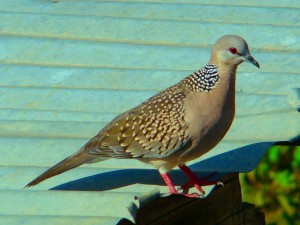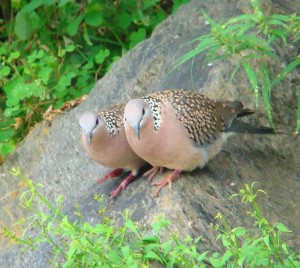
Streptopelia chinensis (Spotted Dove)
The Spotted Dove (Streptopelia chinensis) is a well-known bird species found across a wide range of habitats, from urban environments to rural landscapes. Commonly recognized for its distinct plumage, the Spotted Dove has a pale greyish-brown body with a characteristic black crescent-shaped patch on its nape. Often associated with calm and serenity, it is a symbol of peace in various cultures.
Physical Characteristics of the Spotted Dove
The Spotted Dove is medium-sized, with a body length ranging from 30 to 33 cm. Its greyish-brown feathers are complemented by a pale underbelly, making it an easily recognizable species. One of its most distinctive features is the black spots on its neck, which are the source of its name. This bird has a long, rounded tail and a characteristic cooing call that can be heard from a distance, often in the early morning and evening hours.
Habitat and Distribution
The Spotted Dove is native to South and Southeast Asia, but it has adapted well to human-altered environments. From bustling city streets to quiet rural areas, these doves thrive in diverse habitats. They are often seen in gardens, parks, and farmland, making them a common sight in many parts of Asia, including India, Sri Lanka, and parts of Southeast Asia. Their adaptability has allowed them to expand their range, and they are now found in various countries, including Australia and New Zealand.
Behavior and Diet
The Spotted Dove is typically seen foraging on the ground, where it feeds on seeds, grains, and small fruits. It has a gentle disposition and is often observed in pairs or small groups. While they are peaceful creatures, they do engage in territorial behavior during the breeding season, especially around their nesting areas.
The Role of the Spotted Dove in Ecosystems
The Spotted Dove plays an important role in local ecosystems, particularly in controlling seed populations. By feeding on various seeds, the dove helps prevent certain plants from becoming too dominant in the landscape. Their presence in gardens and parks is beneficial, as they contribute to the natural balance of the area.
| Common Name | Spotted Dove |
| Scientific name | Streptopelia chinensis |
| Family | Columbidae (Doves & Pigeons) |
| Description | The dove has white –spotted, pinkish-brown and grey upperparts, and white chessboard image on its hind neck—leading clue to its identify. The sexes are alike. The dove stays in pairs or parties, in open wooded country, cart tracks, etc—affects open well-wooded and cultivated country; and avoids arid tracts. It becomes quite tame and confiding if unmolested, freely entering gardens and verandas of bungalows. Flights as of other doves, is swift and strong, attained by vigorous wing strokes. |
Conclusion
The Spotted Dove is more than just a beautiful bird; it is a symbol of peace and tranquility. Its gentle nature, along with its widespread presence in diverse habitats, makes it a valuable part of the ecosystems it inhabits. Observing these doves in nature provides a sense of calm and serves as a reminder of the delicate balance of the natural world.




